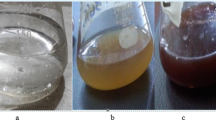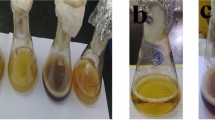Abstract
Extracts of leaf from five native Chilean weeds were evaluated in the biosynthesis of silver nanoparticles. The synthesis was monitored by UV-Vis spectra at 420 nm by typical formation of surface plasmon resonance. Moreover, the extract with major potential for the formation of nanoparticles was used to optimize the synthesis processes by response surface methodology, to obtain nanoparticles of small sizes by combination of three parameters (AgNO3 and leaf extract concentrations and pH). Characterization of AgNPs was made by TEM, XRD, and DLS. The inhibitory activity was evaluated by disk diffusion method and minimum inhibitory concentration (MIC) and minimum bactericidal concentration (MBC) were determined. Only two out of five extracts evaluated (Hypericum perforatum and Malva nicaensis) showed capacity to biosynthesize AgNPs. pH 10, AgNO3 (1 mM), and leaf extract at 5% vv−1 were the optimal conditions to synthesize small AgNPs (< 40 nm). Inhibition zone from diffusion disk assay, MIC (30 μg mL−1) and MBC (40 μg mL−1), revealed a high antibacterial activity of AgNPs against Ralstonia solanacearum. Based on the results, the AgNPs biosynthesized from the leaf extract of H. perforatum is a promising antibacterial agent for its use in the control of R. solanacearum.




Similar content being viewed by others
References
Ahmed S, Ahmad M, Swami BL, Ikram S (2015) Plants extract mediated synthesis of silver nanoparticles for antimicrobial applications: a green expertise. J Adv Res 7:17–28
Bastani S, Hajiboland R, Khatamian M, Saket-Oskoui M (2018) Nano iron (Fe) complex is an effective source of Fe for tobacco plants grown under low Fe supply. J Soil Sci Plant Nutr 18(2):524–541
Chahardooli M, Khodadadi E, Khodadadi E (2014) Green synthesis of silver nanoparticles using oak leaf and fruit extracts (Quercus) and its antibacterial activity against plant pathogenic bacteria. Int J Biosci 4:97–103
Chandran SP, Chaudhary M, Pasricha R, Ahmad A, Sastry M (2006) Synthesis of gold nanotriangles and silver nanoparticles using Aloe vera plant extract. Biotechnol Prog 22:577–583
Champoiseau G, Jones JB, Allen C (2009) Ralstonia solanacearum race 3 biovar 2 causes tropical losses and temperate anxieties. Plant Health Progr 10(1):35
Chen J, Li S, Luo J, Wang R, Ding W (2016) Enhancement of the antibacterial activity of silver nanoparticles against phytopathogenic bacterium Ralstonia solanacearum by stabilization. J Nanomater 2016. Article ID 7135852, 15 pages:1–15. https://doi.org/10.1155/2016/7135852
CLSI (2018) Methods for dilution antimicrobial susceptibility tests for bacteria that grow aerobically; approved standard, 11th ed, M07. Clinical and Laboratory Standards Institute, Wayne, PA
Dhand V, Soumya L, Bharadwaj S, Chakra S, Bhatt D, Sreedhar B (2016) Green synthesis of silver nanoparticles using Coffea arabica seed extract and its antibacterial activity. Mater Sci Eng C: Mater Biol Appl 58:36–43
El-Rahman AF, Mohammad TGM (2013) Green synthesis of silver nanoparticle using Eucalyptus globulus leaf extract and its antibacterial activity. J Appl Sci Res 9:6437–6440
El-Rahman AFA, Mohammad TGM (2014) Green synthesis of silver nanoparticle using Eucalyptus globulus leaf extract and its antibacterial activity. J Appl Sci Res 9:6437–6440
Emmanuel R, Palanisamy S, Chen S-M, Chelladurai K, Padmavathy S, Saravanan M, Prakash P, Ali MA, Fahad MA, Hemaid A (2015) Antimicrobial efficacy of green synthesized drug blended silver nanoparticles against dental caries and periodontal disease causing microorganisms. Mater Sci Eng C 56:374–379
Espinoza N (1996) Malezas presentes en Chile. Instituto de Investigaciones Agropecuarias Carillanca. Concepción. Editora Aníbal Pinto SA 219 p
Golshahi S, Ahangar Gholamalizadeh A, Noshin M, Ghorbani M (2018) A comparison of the use of different sources of nanoscale iron particles on the concentration of micronutrients and plasma membrane stability in sorghum. J Soil Sci Plant Nutr 18(1):236–252
Imada K, Sakai S, Kajihara H, Tanaka S, Ito S (2016) Magnesium oxide nanoparticles induce systemic resistance in tomato against bacterial wilt disease. Plant Pathol 65:551–560
Ito T, Sun L, Bevan MA, Crooks RM (2004) Comparison of nanoparticle size and electrophoretic mobility measurements using a carbon-nanotube-based coulter counter, dynamic light scattering, transmission electron microscopy, and phase analysis light scattering. Langmuir 20:6940–6945
Kanchana A, Agarwal I, Sunkar S, Nellore J, Namasivayam K (2011) Biogenic silver nanoparticles from Spinacia oleracea and Lactuca sativa and their potential antimicrobial activity. Dig J Nanomater Biostruct 6:1741–1750
Lee YH, Choi CW, Kim SH, Yun JG, Chang SW, Kim YS, Hong JK (2012) Chemical pesticides and plant essential oils for disease control of tomato bacterial wilt. Plant Pathol J 28:32–39
Logeswari P, Silambarasan S, Abraham J (2015) Synthesis of silver nanoparticles using plants extract and analysis of their antimicrobial property. J Saudi Chem Soc 19:311–317
Möhler JS, Sim W, Blaskovich MAT, Cooper MA, Ziora ZM (2018) Silver bullets: a new lustre on an old antimicrobial agent. Biotechnol Adv 36:1391–1411
Moreira-Ascarrunz S, Natsuaki T, Honjo H, Fukui R (2011) Quick adaptation of Ralstonia Solanacearum to copper stress to recover culturability and growth in water and soil. Braz J Microbiol 42:576–591
Ondari N, Padmanabhan N (2015) Green chemistry focus on optimization of silver nanoparticles using response surface methodology (RSM) and mosquitocidal activity: Anopheles stephensi (Diptera: Culicidae). Spectrochim Acta A Mol Biomol Spectrosc 149:978–998
Ouda SM (2014) Antifungal activity of silver and copper nanoparticles on two plant pathogens, Alternaria alternate and Botrytis cinerea. Res J Microbiol 9:34–42
Reyes-Estebanez M, Ortega-Morales BO, Chan-Bacab M, Granados-Echegoyen C, Camacho-Chab JC, Pereanez-Sacarias JE, Gaylarde C (2018) Antimicrobial engineered nanoparticles in the built cultural heritage context and their ecotoxicological impact on animals and plants: a brief review. Herit Sci 6:52. https://doi.org/10.1186/s40494-018-0219-9
Rout A, Jena PK, Parida UK, Bindhani BK (2013) Green synthesis of silver nanoparticles using leaves extract of Centella asiatica L. for studies against human pathogens. Int J Pharm Biol Sci 4:661–674
Vadlapudi V, Amanchy R (2017a) Phytofabrication of silver nanoparticles using Myriostachya wightiana as a novel bioresource, and evaluation of their biological activities. Braz Arch Biol Technol 60:e17160329
Vadlapudi V, Amanchy R (2017b) Synthesis, characterization and antibacterial activity of silver nanoparticles from red algae, Hypnea Musciformis. Adv Biol Res 11:242–249
Wang X, Liu X, Han H (2013a) Evaluation of antibacterial effects of carbon nanomaterials against copper-resistant Ralstonia solanacearum. Colloids Surf B: Biointerfaces 103:136–142
Wang X, Liu X, Han H (2013b) Evaluation of antibacterial effects of carbon nanomaterials against copper-resistant Ralstonia solanacearum. Colloids Surf B Biointerfaces 103:136–142
Wang L, Hu C, Shao L (2017) The antimicrobial activity of nanoparticles: present situation and prospects for the future. Int J Nanomedicine 12:1227–1249
Yeshchenko OA, Dmitruk IM, Alexeenko AA, Kotko AV, Verdal J, Pinchuk AO (2012) Size and temperature dependence of the surface plasmon resonance in silver nanoparticles. Ukr J Phys 57:266–277
Yuliar, Nion YA, Toyota K (2015) Recent Trends in Control Methods for Bacterial Wilt Diseases Caused by Ralstonia solanacearum. 30(1):1–11
Zargar M, Hamid AA, Bakar FA, Shamsudin MN, Shameli K, Jahanshiri F (2011) Green synthesis and antibacterial effect of silver nanoparticles using Vitex Negundo L. Molecules 16:6667–6676
Funding
This work was financed by MEC-CONICYT 80170096 and 80170089 and partially financed by DI18-2024 and FONDECYT 1161713.
Author information
Authors and Affiliations
Corresponding author
Additional information
Publisher’s Note
Springer Nature remains neutral with regard to jurisdictional claims in published maps and institutional affiliations.
Rights and permissions
About this article
Cite this article
Tortella, G., Navas, M., Parada, M. et al. Synthesis of Silver Nanoparticles Using Extract of Weeds and Optimized by Response Surface Methodology to the Control of Soil Pathogenic Bacteria Ralstonia solanacearum. J Soil Sci Plant Nutr 19, 148–156 (2019). https://doi.org/10.1007/s42729-019-00021-2
Received:
Accepted:
Published:
Issue Date:
DOI: https://doi.org/10.1007/s42729-019-00021-2




